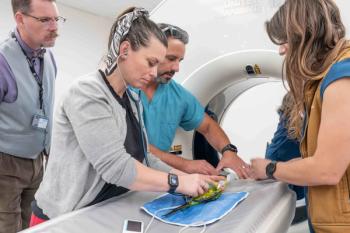
Liver or let die: ultrasonography of hepatobiliary and pancreatic diseases (Proceedings)
Before pathology can be discussed, the normal appearance of the liver, biliary system, and pancreas will be reviewed. Determination of liver size via US is not accurate and is best done on radiographs. Ultrasound is best performed with the animal in dorsal recumbency (on their back) and the area must be clipped free of hair.
Before pathology can be discussed, the normal appearance of the liver, biliary system, and pancreas will be reviewed. Determination of liver size via US is not accurate and is best done on radiographs. Ultrasound is best performed with the animal in dorsal recumbency (on their back) and the area must be clipped free of hair. Generous amounts of isopropyl alcohol and US gel should be applied. In deep chested breeds, such as boxers and greyhounds, you may need to scan via the intercostal spaces to completely image the liver. The liver consists of 6 lobes: right lateral, right middle, left lateral, left middle, caudate and quadrate. Normally, you cannot distinguish between lobes with US. The liver has a medium level homogeneous echotexture (is slightly more echogenic than renal cortex, but less than that of spleen at the same imaging depth). The liver is moderately coarse compared to the spleen and has smooth serosal margins.
The intrahepatic vasculature appears as anechoic, tubular structures in the liver parenchyma that taper towards the periphery. There are three types of intrahepatic vessels. The portal veins have hyperechoic walls. The hepatic veins have walls that are not normally visible. And lastly, the hepatic arteries, are very small and not usually seen. The extrahepatic vasculature consists of the caudal venal cava, the portal vein and the aorta. The caudal vena cava is anechoic, tubular and the walls are not seen. The caudal vena cava is in the dorsal abdomen and is located to the right of midline. It can be traced into and through the diaphragm. The portal vein is also anechoic and tubular but has hyperechoic walls. It is located ventral to the caudal vena cava and is located more on midline. The aorta is located to the left of midline and is the most dorsally located vessel. Doppler evaluation of the aorta shows arterial flow profile, while both the caudal vena cava and the portal vein have venous flow profiles. The gall bladder and bile ducts are located within the hepatic parenchyma. They are anechoic, smoothly marginated, variously sized (depends on time of most recent meal), and thin walled. The bile ducts are differentiated from intrahepatic vessels with Doppler, as they will have no flow. The gall bladder is located to the right of midline and there is distal acoustic enhancement. The normal common bile duct can be difficult to identify due to small size. A normal common bile duct in a cat is 4mm or smaller and in a dog 3mm or smaller.
The pancreas is considered normal if you cannot see it on US. The normal pancreas has a body and right and left lobes. The body of the pancreas is arbitrarily defined, and is in the middle of the right and left lobes. The right lobe is just dorso-medial to the descending duodenum. The left lobe is located just caudal to the body of the stomach, just cranial to the transverse colon. The right lobe is usually easier to find than the left. To definitively identify the pancreasy, you initially will need to find the descending duodenum. The descending duodenum is usually the lateral most bowel loop in the right cranial abdominal quadrant. Search medial to the descending duodenum and cranial to the right kidney. The left lobe is usually difficult to see due to overlying gas in the stomach and colon. Scan the area just caudal to the greater curvature of the stomach and cranial to the colon, medial to the spleen.
Now that we are familiar with the normal appearance of the liver, biliary system, and pancreas, pathology of these will be discussed. It is important to realize that most sonographic signs of liver disease are non-specific. Clinically, lesions of the hepatobiliary system can be divided into those that involve the liver parenchyma, vascular lesions, and lesions that involve the gall bladder or biliary system alone. Lesions should also be classified as to their echogenicity, distribution, presence of any artifacts, and effect on surrounding structures. Diseases that affect an organ in a diffuse manner are very hard to diagnose, and careful inspection and comparison to surrounding organs is needed.
Benign hepatic parenchymal lesions include hepatic lipidosis, nodular regeneration, hepatic cirrhosis, hepatitis, passive congestion, abscesses, cysts, superficial necrolytic dermatitis, and benign tumors. Hepatic lipidosis is common in cats and restults from anorexia, starvation, diabetes, and obesity. The liver appears enlarged on radiographs and is diffusely hyperechoic on ultrasound. It is easy to compare the liver to the echogenicity of the adjacent falciform fat (it should be hypo to isoechoic to the fat). There is reduced visualization of the intrahepatic portal vasculature. Nodular regeneration is a very common finding in both cats and dogs. You cannot distinguish this from metastatic disease using US alone. Aspiration or biopsy is required to make a histologic diagnosis. These appear as focal to multifocal, rounded, variously sized, hypoechoic and sometimes even hyperechoic nodules throughout the liver. Hepatic cirrhosis is also known as chronic "end-stage" liver disease. The liver is diffusely hyperechoic throughout the parenchyma and the serosal margins are rounded and irregular (leaf like). The liver is small on radiographs. Usually seen in older animals, though can be end result of toxin ingestion (Sago palm) or chronic fibrosis due to drug administration (Phenobarbital). Hepatitis most commonly appears as a diffusely decreased hepatic echogenicity. The liver may be radiographically normal or increased in size. With passive congestion the liver also appears diffusely decreased in echogenicity and there are enlarged dilated intrahepatic vessels. Radiographically the liver is large. Abscesses are most often focal lesions. Their appearance depends on the maturity (age) of the abscess. Early on the center is filled with liquid (pus) which appears homogeneous, and either anechoic to hypoechoic. The central area may contain floating debris and may or may not have posterior enhancement. The walls are thick (>3-4 mm). Later on in the disease process the centrally located pus becomes inspissated and appears heterogenous, echogenic to hyperechoic. The walls may at this time be indistinct. Posterior enhancement is no longer identified. Hepatic cysts are common most often incidental findings. Most are congenital and can be focal to multifocal. They are thin walled, filled with anechoic fluid and have sharp posterior enhancement. Often seen in conjunction with polycystic kidney disease. Canine superficial necrolytic dermatitis (aka hepatocutaneous syndrome) is seen in middle aged to older, small to medium sized dogs. These patients present fro multiple, crusty, ulcerative, keratinous lesions and the mucocutaneous junctions, foot pads, genital area, and pressure points on the elbows. Can also be associated with glucagonomas, diabetes mellitus, and hyperglycemia. The liver appears "honeycomb" like. This is due to multiple variously sized anechoic regions surrounded by a lattice framework which represents regenerative nodules surrounded by fatty connective tissue. Hemangioma and hepatoma are benign tumors of the liver that are unfortunately indistinguishable from malignant tumors.
Malignant hepatic parenchymal lesions include hepoatocellular adenocarcinoma, cholangiocellular carcinoma, lymphosarcoma, and metastatic neoplasia. Hepatocellular adenocarcinoma is the most common primary liver neoplasia in the dog. It has a varied sonographic appearance and can be solitary hyperechoic (most common), multifocal hyperechoic, or solitary hypoechoic. There are often poorly defined margins and they someimes have a "target appearance" (hypoechoic center surrounded by hyperechoic rim). Cholangiocelluar carcinoma is commonly found in cats. It arises from intrahepatic bile ducts and is therefore seen multifocally throughout the liver and can be either hyper or hypoechoic nodules. Cholangiocellular carcinomas can also have poorly defined margins. Lymphosarcoma appearance is highly variable and can include a normal appearing hepatic parenchyma, diffusely hypoechoic, diffusely hyperechoic, or mottled, hypoechoic nodules. Metastatic neoplsia is also most commonly multifocal. These too can be hyperechoic, hypoechoic, or mixed echogenicity.
Hepatic vascular diseases include passive (cardiogenic) congestion and portosystemic shunts. Passive (cardiogenic) congestion is the result of non-compensated right heart disease (either tricuspid insufficiency, dilated cardiomyopathy, Chagas disease, pericardial effusion, or right sided heart mass). There are dilated, enlarged hepatic veins, diffuse decreased echogenicity of the liver parenchyma, and caudal vena cava is dilated and enlarged. Portosystemic shunts are either congenital or acquired. Congenital shunts are usually a single vessel while acquired shunts are multiple anomalous vessels. Congenital shunts are more common. Intra-hepatic shunts (persistent ductus venosus) are seen in large breed dogs while extra-hepatic shunts are found in small breed dogs and cats. Sensitivity for detection of single vessel, extra-hepatic shunts is extremely operator dependent. Portal scintigraphy is often used to confirm the diagnosis when ultrasonographic findings are not conclusive. Extra-hepatic, multi-vessel, acquired shunt commonly are seen as multiple torturous vessels just caudal to the liver and cranial to the left kidney.
Disease of the gall bladder and bile ducts include choleliths, biliary sludge, and biliary obstruction. Choleliths ("gall stones") are easily detected with ultrasound (nearly 100% sensitivity). Choleliths rarely cause disease in dogs and cats (unlike humans). Both radiopaque and radiolucent stones will be seen with ultrasound. Choleliths are gravity dependent, focal hyperechoic structures with posterior shadowing. Gall bladder "sludge" is an extrememly common ultrasound finding in dogs. The entire lumen of the gall bladder can be filled. It is usually gravity dependent. The gall bladder will partially empty after a meal. Posterior shadowing is not present. Choleliths may be difficult to image in highly echogenic sludge. The appearance of biliary obstruction depends on the level of obstruction. Since cholelithiasis is uncommon in animals, biliary obstruction is usually due to extraluminal compression by neoplasia, infection, or fungal disease. The gall bladder may be very large if the animal is anorectic. Acute and chronic cholecystitis causes diffuse thickening of the gall bladder wall. However gall bladder wall thickening is not specific for this condition and can be caused by a plethora of other diseases. If gas producing bacteria are causing the cholecystitis, gas bubbles may be noted which appear as multiple hyperechoic structures that float and have posterior shadowing. Several inconsequential and thus incidnetal congenital anomalies of the biliary system are seen. Cats can have a bilobed gall bladder. This is a gall bladder with a partially divided lumen that converges into one cystic duct. By comparison a double gall bladder is two separate gall bladders, each with their own cystic duct. Pathologic processes seen in the pancreas include nodular hyperplasia, pancreatitis, abscess, insulinoma, and adenocarcinoma. Nodular hyperplasia is a benign process that appears as hypoechoic to isoechoic nodules. They cannot be differentiated from neoplasia and at times can appear cystic. Pancreatitis can be diagnosed when ultrasonographic findings are present. However the lack of ultrasonographic findings does not rule out the possibility of pancreatitis being present (common in mild cases). With moderate to severe pancreatitis the pancreas becomes hypoechoic (due to hemorrhage and necrosis), mottled in echotexture, with surrounding free peritoneal fluid and hyperechoic mesentery (both representing peritonitis). Other signs to look for that suggest pancreatitis include functional ileus of the descending duodenum (thick walls, with little to no evidence of peristalsis), lateral displacement of the descending duodenum (mass effect), and a large distended gall bladder with sludge in it. Pancreatic abscesses often occur as a sequella to pancreatitis. Therefore findings are often similar however additionally a large, well defined, thick walled, anechoic to hypoechoic mass lesion is noted that has irregular internal margination. Two types of neoplasia are common in the pancreas. Adenocarcinoma is the most commonly diagnosed tumor. They arise from acinar cells or ductal epithelium. They develop in the central portion of the gland (body). As they grow the may compress the common bile duct, invade the adjacent gastric and duodenal segments, and frequently metastasize to the liver. They appear as poorly echogenic nodules or masses. Insulinomas are uncommonly diagnosed with ultrasound due to the very small size of the nodules. Most endocrine tumors are malignant and tend to spread to the regional lymph nodes and liver and therefore ultrasound is recommended to look for evidence of metastasis. It is important to understand that pancreatic tumors usually present as a focal nodule or mass and therefore can be difficult to differentiate from nodular hyperplasia or small abscesses.
Newsletter
From exam room tips to practice management insights, get trusted veterinary news delivered straight to your inbox—subscribe to dvm360.






